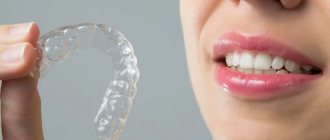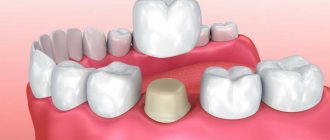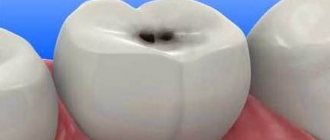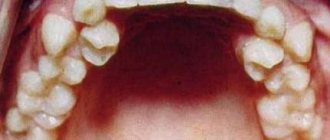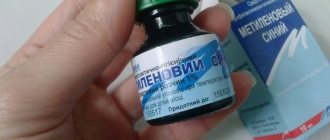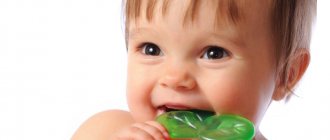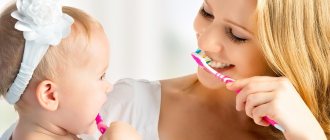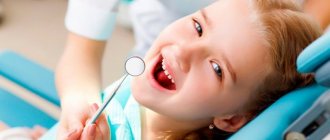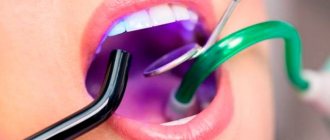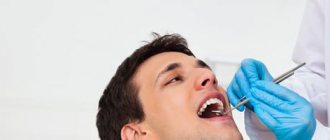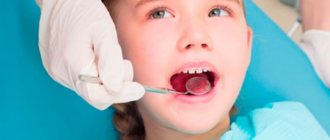The period of childhood when a child delights you with his toothless smile passes about five months after birth: at this time teething usually begins. Between the sixth and eighth months of life, the central incisors of the lower jaw begin to appear, and then the upper. By 8-12 months - lateral incisors, first on the lower and then on the upper jaw. By 12-16 months, temporary chewing teeth erupt, by 16-20 months - canines, and by 20-30 months - second chewing teeth, which complete the formation of the primary bite.
Why should you brush your baby teeth?
Many young mothers believe that brushing their baby teeth is not necessary because they will fall out anyway. However, decaying teeth
are always pain, discomfort and a source of spread of pathogenic bacteria.
How to brush your teeth correctly
How often, what to use, and in what mode is it better to brush your teeth? Detailed instructions for children and adults.
In addition, the early habit of brushing teeth becomes natural for the child and will help him preserve the health of his molars.
How to teach a child to brush their teeth
Familiarity with oral hygiene should begin as early as possible. These 4 principles will help teach your child to brush their teeth correctly and form a responsible attitude towards dental health.
- Regularity
. Follow the regime. It is best to teach your child to brush his teeth at the same time in the morning and evening. - Personal example
. It works better than any persuasion. At the very beginning, take your child with you to the bath and give him a brush - let him try to simply repeat after you. Over time, the game will become a habit, and he will remind you to brush your teeth. - Choice
. This is not a choice between “cleaning” and “not cleaning.” Let your child choose his own toothpaste and brush, or better yet, a few to suit his mood. Variety every day will not let him get bored. - Motivation
. Don't force, but motivate. Get your baby interested through games, a timer or a special calendar (we'll talk about it below). With proper motivation, the child will not even notice how he will begin to follow all your recommendations with pleasure.
For successful motivation, you can also try different options.
- Timer
. Agree with your child in advance that brushing your teeth will take exactly as long as the sand is poured in (doctors recommend at least 2 minutes). As a result, the baby will not try to finish quickly, but will begin to watch the grains of sand. In addition to the usual hourglass, there are brushes with a timer. - Teeth brushing calendar
. Hang it in the bathroom in a visible place, but so that the child can easily reach it. The teeth cleaning calendar can be of any type and design. For example, it may consist of 30 or 31 windows depicting the sun and moon. Each time, after brushing their teeth, the child will paint over or cover with a sticker the sun (in the morning) and the moon (in the evening). - Means for detecting dental plaque
. They allow you to quickly and easily monitor the effectiveness of teeth brushing in children, motivating them to take careful care. The products turn plaque blue, after which it can be easily removed with a toothbrush.
Hourglass for monitoring miradent cleaning time
Teeth brushing calendar for children
miradent Plaque Agent Plaque Indicator Rinse
And don't forget to celebrate your baby's successes. Praise always motivates you to new achievements. For example, give your child figurines or stickers that he likes at the end of the week. The main thing is to agree with him about this in advance.
How are the first teeth cut?
Teaching your child the rules of personal hygiene
Children are taught hygiene procedures from the first days of life. Find out how to teach your child to practice personal hygiene on his own.
The main symptoms of teething in infants are increased salivation and swelling of the gums.
The process is usually uncomfortable for the child and may be accompanied by increased moodiness and crying for no reason, insomnia and loss of appetite. A slight increase in temperature
(up to 38°C) may be a natural protective reaction of the body, but in this case the child should be shown to a doctor.
You can help the baby a little. Buy several teethers
- rubber or plastic toys for the child to bite on.
Chewing rings with liquid inside, which are first placed in the refrigerator to cool, has a particularly soothing effect. Additional methods
: Gently massage the baby's gums with a gauze pad soaked in cold water, or use baby teething gels with anesthetics, which the pediatrician will recommend.
Teething symptoms
- there may be a slight fever;
- anxiety - the child becomes capricious, sleeps poorly, often wakes up at night;
- decreased appetite;
- excessive salivation and, as a result, redness of the skin around the mouth;
- swelling and redness at the site of tooth eruption, possible formation of hematomas on the gum mucosa;
- increased need for the baby to chew on something: pacifier, toys, fingers.
There are children whose teeth appear asymptomatically and even unnoticed by their parents. But, as a rule, this process is accompanied by an individual combination of the signs given in the list above.
What foods are good for your first teeth?
Foods rich in calcium
.
First of all, it is cottage cheese and hard cheese. Slightly less calcium is found in milk, fermented milk products, green leafy vegetables, gooseberries, currants, and cherries. Sources of vitamin D, without which calcium cannot be absorbed, are egg yolk and butter. You should include carbohydrate foods in your child’s diet less often: bread, potatoes, and especially sugar and sweet foods. Sweets provoke the active proliferation of bacteria in the mouth, which leads to early caries
. “The longer you don’t offer your child sweets, the better,” says Kuznetsova, “for example, children under three years old should not be given chocolate at all.”
How does caries occur?
The main causes of caries are improper oral care combined with poor diet. During the day, a plaque consisting of food debris and particles of saliva forms on the surface of the enamel. A particular danger to enamel is lactic acid, which is formed from sugars under the influence of microbes that inhabit the oral cavity.
Another cause of caries is the formation of a malocclusion. What can disrupt the formation of bite? At the age of 2 to 6 years, the following reasons are important: defective posture, mouth breathing, chewing and swallowing with an open mouth, the predominance of soft foods in the diet that do not require active chewing, the child’s habit of holding food in his cheek for a long time.
How to care for baby teeth?
From the moment the first baby teeth appear (6-8 months)
, and up to a year, parents should brush the child’s teeth with a special silicone brush placed on a finger at least once a day.
From the age of one year,
a child can brush his teeth twice a day with a very soft children's toothbrush, moving from the gums to the cutting edge or chewing surface of the teeth.
From 2-2.5 years old,
children's gel toothpaste should be used.
The amount of paste per cleaning should not exceed the size of a pea. From the age of 3,
children's teeth are brushed twice a day with a very soft toothbrush and children's toothpaste.
From the age of 2-3 years
, a child can be taught to brush his teeth independently under the mandatory supervision of his parents.
What affects the timing of teething?
Processes in the body are individual, including timing. The age at which the first teeth appear is determined by a number of factors:
- Heredity.
- The intrauterine period and negative factors affecting the fetus (for example, a pregnant woman taking certain medications).
- Nutrition for the expectant mother during the period of waiting for the baby and breastfeeding.
Introduction of complementary foods, etc.
Choosing a brush and toothpaste for your baby
How to choose a toothbrush
Conventional, electric or ultrasonic? Soft or hard? Synthetic or natural? Accurate answers to all questions.
A baby toothbrush looks like this.
It has a short working part - from 18 to 25 mm. Until the age of five, a child has a brush with very soft (extra soft) synthetic bristles, and from a later age - with soft bristles with rounded ends. The handle of the children's brush is thicker, with non-slip inserts - this makes it easier for the baby to hold it. Children's toothpastes
are also different from adults. They are low in abrasives, low in fluoride, and contain fruity fragrances and flavors. Look carefully at what age of children this or that toothpaste is intended for.
How to choose toothpaste for a child
The issue of choosing the right toothpaste for a child worries many responsible parents. The fact is that toothpastes should not only effectively clean children’s teeth, but also carefully act on tooth enamel, without damaging or causing other harm to it. Manufacturers take into account the characteristics of children's teeth and supply toothpastes intended for children with soft abrasive microparticles.
The paste should also have preventive properties and contain such substances as fluorine, calcium and phosphorus that are beneficial for tooth enamel. These substances have the unique property of becoming part of the crystal lattice of tooth enamel and significantly strengthening it. Fluoride is especially important. Its amount in toothpaste varies depending on the age of the child. Therefore, when choosing a toothpaste, you should read the recommendations about the child’s age indicated on its packaging.
If a child suffers from allergies, then he needs to use a special dental formula that has hypoallergenic properties. This product contains no artificial colors, preservatives or flavors. Even for healthy children, you should not purchase toothpaste with a strong fragrance and a brightly poisonous color.
What parents need to remember
The baby should see the dentist for the first time at six months, and the first tooth should be cleaned with a special brush.
Sweets harm the first teeth, but daily brushing with a special children's brush and toothpaste is beneficial. Tags:
- Hygiene
- Teeth
- Preschoolers
- Babies
- Kuzmina
2 comments • To leave a comment you must be an authorized user
- tancuet massage "methods: gently massage the gums"
- irina_golovleva at 6-8 months a child can be given hard cheese, gooseberries, currants, cherries???????!!!!!!!!!!!!!!!!!!!!!!!!!!! !!!
Features of oral care for children and adolescents in Ufa
Features of oral care from birth to one year
Treatment of the oral cavity must begin with the use of special dental wipes. Such napkins have a pleasant smell and taste of various fruits, which also stimulates the baby’s interest and gives a pleasant feeling. The napkins are made of a special non-woven material and impregnated with a special solution - xylitol.
It is absolutely safe for children and has a detrimental effect on pathogenic microflora. The method of using napkins is quite simple and will not cause any inconvenience to the baby and parents. Mom or dad puts a dental wipe on their index finger, takes the baby in their arms, and in a reclining position, treats the entire oral cavity of the baby. Particular emphasis should be placed on treating the child’s cheeks and, if possible, the tongue. At the time of teething, when the baby’s gums are inflamed, it is necessary to treat the gums especially carefully with light massage movements. This helps to alleviate the child’s condition, reduce discomfort and inflammation in the gums. As for the frequency of cleaning the oral cavity, like adults, children need to do it 2 times a day.
First toothbrush
From the moment of teething, it is necessary to use a finger toothbrush. It is made of silicone and comes in two types: with a fleecy and ribbed working surface. The ribbed surface removes plaque from the teeth well, but such a brush is not capable of massaging the gums, which is so necessary for teething babies. Massage can help alleviate the condition and reduce inflammation in the baby’s oral cavity. As for the fleecy surface, it not only perfectly cleans teeth of plaque, but is also capable of massage.
There is a set of toothbrushes - this is a step-by-step system for teaching yourself how to brush your teeth. The first brush for babies aged 6-8 months who have already had their first tooth. A soft rubber brush with short bristles easily cleans dirt and does not injure your baby's delicate teeth and gums.
Second brush for babies aged 8-12 months. A brush with rubber bristles prepares your baby for the transition to a regular brush. The third brush is for babies aged one to three years. At this point, the child learns to brush his teeth independently. Soft bristles remove dirt without damaging the enamel of baby teeth and gums.
Pasta selection
At each age, the requirements for toothpaste are strictly individual. The first toothpaste for a baby should be special. These toothpastes contain lactic enzymes and xylitol, which gives the toothpaste a pleasant taste that kids like so much. There are adapted toothpastes for early ages. They take into account the fact that the baby will swallow most of the toothpaste.
If the structure of tooth enamel is damaged, it is necessary to use remineralizing drugs. They effectively deal with demineralized areas of enamel - caries at the white spot stage, returning the enamel to its natural color and structure. It also helps in the prevention and treatment of caries at any stage, multiple carious lesions of the oral cavity.
Features of oral care from 1 year to 7 years
After a year, you can buy a real baby brush. The very first brush should be chosen strictly according to the child’s age - they are all marked accordingly. A children's brush should have soft bristles and the size of the working part should be such as to capture 1.5-2 baby teeth.
To stimulate the baby’s interest and create positive emotions, modern toothbrushes have multi-colored bristles, a handle in the shape of a favorite cartoon character, or with bright pictures, which makes it easier to stimulate interest and gives positive emotions from its use. The toothbrush handle should be thick, comfortable for the baby’s hand, because the joints of the hand are still poorly developed, and the baby has certain difficulties in holding a thin toothbrush in his hand. The brush needs to be changed every two months. But there are cases when the brush must be changed regardless of its service life. For example, after a sore throat or stomatitis, since there is a risk of re-infection.
It is necessary to teach a child how to brush their teeth independently at the age of 2-3 years, using game techniques that make it easier to understand and remember the sequence of actions when performing hygiene procedures. Toothpaste, in the amount indicated on the tube, should be applied to the toothbrush by an adult family member.
In general, children under 6 years of age are not recommended to use mouthwash (dental rinse). If necessary, preschoolers can use rinses (under adult supervision!) that do not contain fluoride and alcohol, which have only a deodorizing effect, using no more than 5 ml of solution per use.
To teach a child of preschool and primary school age to brush their teeth correctly, special tablets and solutions were developed that, when they enter the oral cavity, stain the remaining plaque that was not removed during brushing.
An absolutely essential component of dental care is regular visits to the dentist, because baby teeth can also get sick. In addition to examining and performing therapeutic and preventive procedures, the pediatric dentist will certainly give advice on the rules of oral care, drawing the attention of parents to points that are important specifically for their child.
Features of oral care in children over 7 years of age and in adolescents
At this age, it is necessary to strengthen and improve children’s ability to care for their teeth and oral cavity. Even after the child has mastered all the necessary steps, parents should personally supervise the teeth brushing process at least 1-2 times a week.
A toothbrush for a schoolchild should be selected according to age; the bristles should be either soft or medium soft. The shape of the working surface of the brushes can be different.
The choice of toothpaste depends on the severity of caries. If there is a high degree of caries intensity and a high risk of its development, fluoride toothpastes are used. To strengthen the enamel and eliminate caries in the white spot stage, it is possible to use remineralizing toothpastes. They promote mineralization of enamel during the growth of permanent teeth.
At the age of 12, the last baby teeth fall out, after which the child can switch to using adult toothbrushes. Then you can allow your child to use an electric toothbrush, carefully monitoring, at first, the quality of hygiene procedures.
“Smart” toothbrushes are becoming very popular. These are electric toothbrushes that sync with an app via Bluetooth so your child can see how well they brush their teeth and receive virtual rewards for it. The application collects and analyzes the duration of each procedure and collects statistics about the child’s teeth brushing; parents can set tasks for the child.
The interdental spaces for oral hygiene are the most difficult surfaces of the teeth; under no circumstances can they be cleaned with a toothbrush. Dental floss does the job that a toothbrush cannot do. It is designed to remove food fragments and plaque from interdental spaces. Even the finest toothbrush bristles cannot clean them effectively. The accumulation of plaque on proximal surfaces is fraught with the development of caries. Therefore, dental floss is not a cosmetic accessory that can be neglected, but a necessary component of oral hygiene along with a toothbrush and toothpaste. Children can floss independently from the age of 9-10 years.
The use of floss has limited application due to the anatomical features of the oral cavity and each tooth. The safest, most effective and fastest method of cleaning interdental spaces is the use of interdental brushes, which are individually selected, completely fill and clean the interdental space.
The use of rinses (elixirs) to maintain fresh breath is permitted, provided that it is an elixir specially created for children and adolescents. It will serve as an additional means to compensate for errors in brushing your teeth. A properly selected mouthwash in combination with toothpaste provides maximum care for the child’s teeth and gums, reducing the risk of caries.
An oral irrigator is the only way to remove all plaque and food debris from hard-to-reach places. This is a device that delivers a pressurized stream of liquid to certain areas of the mouth. It is she who penetrates into hard-to-reach places, removing food debris, bacteria and plaque from there. The kit may include different attachments: for cleaning the tongue, for caring for dentures and braces, and also for cleaning gum pockets.
Recommendations on visiting the dentist and eating habits remain relevant at this age.
